Leadership Guidance for Healthcare Professionals
VerifiedAdded on 2023/06/12
|15
|3834
|128
AI Summary
This article discusses the importance of good leadership in healthcare and how it affects the efficiency and development of an organization. It shares a real-life experience of a nursing leader in improving the performance of the surgery department by guiding and training the staff on the correct procedure of intramuscular injection. The article also analyzes the leadership commitments and practices according to Posner and Kouzes.
Contribute Materials
Your contribution can guide someone’s learning journey. Share your
documents today.
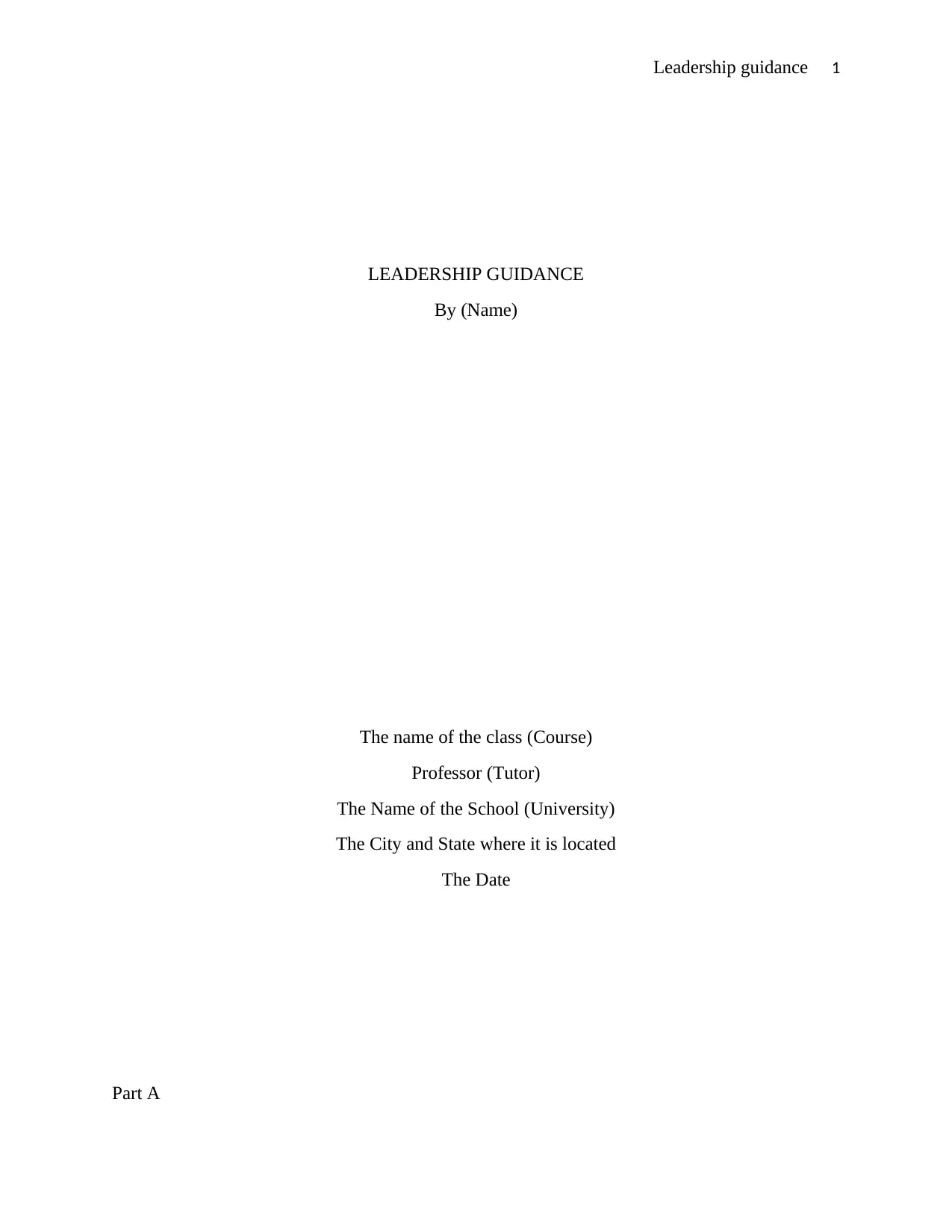
Leadership guidance 1
LEADERSHIP GUIDANCE
By (Name)
The name of the class (Course)
Professor (Tutor)
The Name of the School (University)
The City and State where it is located
The Date
Part A
LEADERSHIP GUIDANCE
By (Name)
The name of the class (Course)
Professor (Tutor)
The Name of the School (University)
The City and State where it is located
The Date
Part A
Secure Best Marks with AI Grader
Need help grading? Try our AI Grader for instant feedback on your assignments.
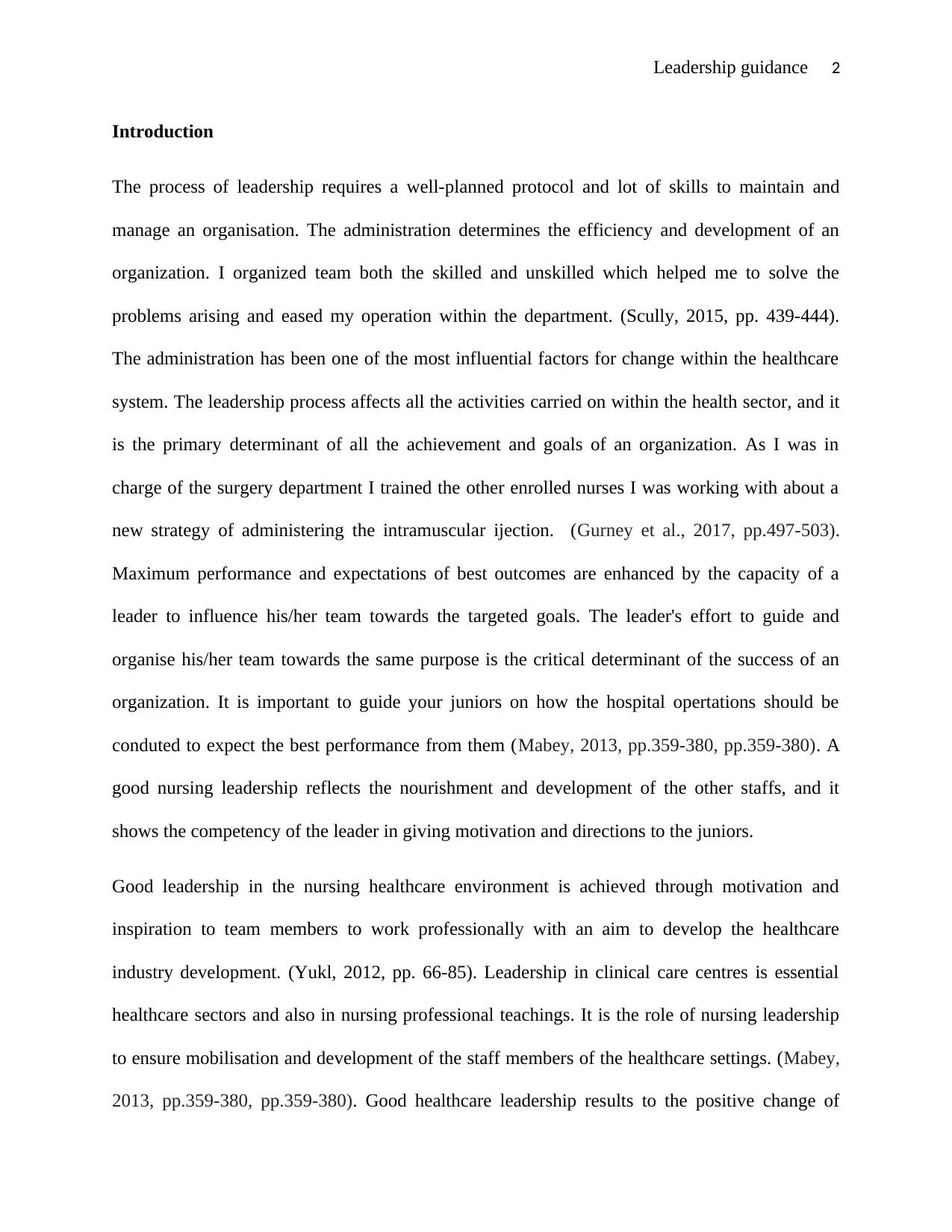
Leadership guidance 2
Introduction
The process of leadership requires a well-planned protocol and lot of skills to maintain and
manage an organisation. The administration determines the efficiency and development of an
organization. I organized team both the skilled and unskilled which helped me to solve the
problems arising and eased my operation within the department. (Scully, 2015, pp. 439-444).
The administration has been one of the most influential factors for change within the healthcare
system. The leadership process affects all the activities carried on within the health sector, and it
is the primary determinant of all the achievement and goals of an organization. As I was in
charge of the surgery department I trained the other enrolled nurses I was working with about a
new strategy of administering the intramuscular ijection. (Gurney et al., 2017, pp.497-503).
Maximum performance and expectations of best outcomes are enhanced by the capacity of a
leader to influence his/her team towards the targeted goals. The leader's effort to guide and
organise his/her team towards the same purpose is the critical determinant of the success of an
organization. It is important to guide your juniors on how the hospital opertations should be
conduted to expect the best performance from them (Mabey, 2013, pp.359-380, pp.359-380). A
good nursing leadership reflects the nourishment and development of the other staffs, and it
shows the competency of the leader in giving motivation and directions to the juniors.
Good leadership in the nursing healthcare environment is achieved through motivation and
inspiration to team members to work professionally with an aim to develop the healthcare
industry development. (Yukl, 2012, pp. 66-85). Leadership in clinical care centres is essential
healthcare sectors and also in nursing professional teachings. It is the role of nursing leadership
to ensure mobilisation and development of the staff members of the healthcare settings. (Mabey,
2013, pp.359-380, pp.359-380). Good healthcare leadership results to the positive change of
Introduction
The process of leadership requires a well-planned protocol and lot of skills to maintain and
manage an organisation. The administration determines the efficiency and development of an
organization. I organized team both the skilled and unskilled which helped me to solve the
problems arising and eased my operation within the department. (Scully, 2015, pp. 439-444).
The administration has been one of the most influential factors for change within the healthcare
system. The leadership process affects all the activities carried on within the health sector, and it
is the primary determinant of all the achievement and goals of an organization. As I was in
charge of the surgery department I trained the other enrolled nurses I was working with about a
new strategy of administering the intramuscular ijection. (Gurney et al., 2017, pp.497-503).
Maximum performance and expectations of best outcomes are enhanced by the capacity of a
leader to influence his/her team towards the targeted goals. The leader's effort to guide and
organise his/her team towards the same purpose is the critical determinant of the success of an
organization. It is important to guide your juniors on how the hospital opertations should be
conduted to expect the best performance from them (Mabey, 2013, pp.359-380, pp.359-380). A
good nursing leadership reflects the nourishment and development of the other staffs, and it
shows the competency of the leader in giving motivation and directions to the juniors.
Good leadership in the nursing healthcare environment is achieved through motivation and
inspiration to team members to work professionally with an aim to develop the healthcare
industry development. (Yukl, 2012, pp. 66-85). Leadership in clinical care centres is essential
healthcare sectors and also in nursing professional teachings. It is the role of nursing leadership
to ensure mobilisation and development of the staff members of the healthcare settings. (Mabey,
2013, pp.359-380, pp.359-380). Good healthcare leadership results to the positive change of
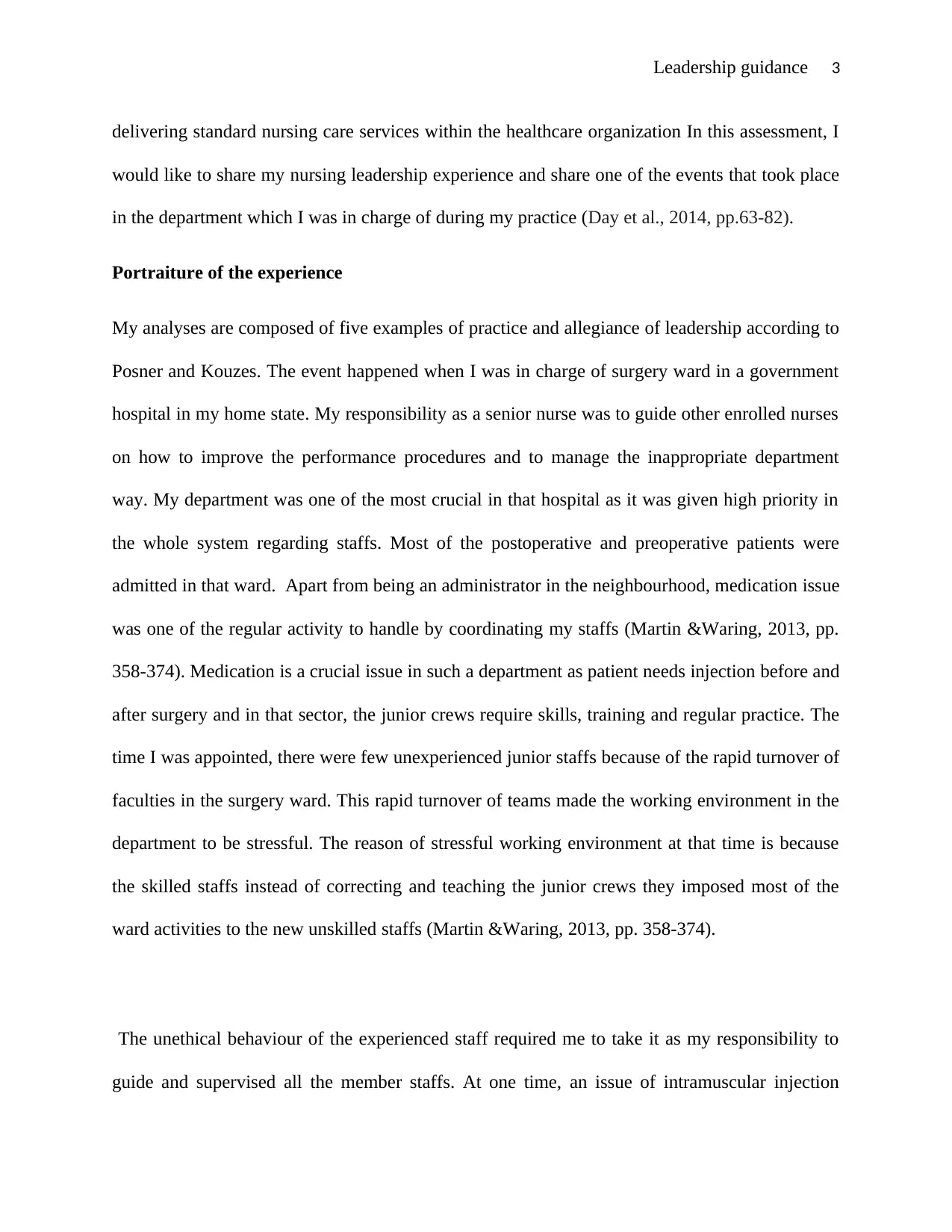
Leadership guidance 3
delivering standard nursing care services within the healthcare organization In this assessment, I
would like to share my nursing leadership experience and share one of the events that took place
in the department which I was in charge of during my practice (Day et al., 2014, pp.63-82).
Portraiture of the experience
My analyses are composed of five examples of practice and allegiance of leadership according to
Posner and Kouzes. The event happened when I was in charge of surgery ward in a government
hospital in my home state. My responsibility as a senior nurse was to guide other enrolled nurses
on how to improve the performance procedures and to manage the inappropriate department
way. My department was one of the most crucial in that hospital as it was given high priority in
the whole system regarding staffs. Most of the postoperative and preoperative patients were
admitted in that ward. Apart from being an administrator in the neighbourhood, medication issue
was one of the regular activity to handle by coordinating my staffs (Martin &Waring, 2013, pp.
358-374). Medication is a crucial issue in such a department as patient needs injection before and
after surgery and in that sector, the junior crews require skills, training and regular practice. The
time I was appointed, there were few unexperienced junior staffs because of the rapid turnover of
faculties in the surgery ward. This rapid turnover of teams made the working environment in the
department to be stressful. The reason of stressful working environment at that time is because
the skilled staffs instead of correcting and teaching the junior crews they imposed most of the
ward activities to the new unskilled staffs (Martin &Waring, 2013, pp. 358-374).
The unethical behaviour of the experienced staff required me to take it as my responsibility to
guide and supervised all the member staffs. At one time, an issue of intramuscular injection
delivering standard nursing care services within the healthcare organization In this assessment, I
would like to share my nursing leadership experience and share one of the events that took place
in the department which I was in charge of during my practice (Day et al., 2014, pp.63-82).
Portraiture of the experience
My analyses are composed of five examples of practice and allegiance of leadership according to
Posner and Kouzes. The event happened when I was in charge of surgery ward in a government
hospital in my home state. My responsibility as a senior nurse was to guide other enrolled nurses
on how to improve the performance procedures and to manage the inappropriate department
way. My department was one of the most crucial in that hospital as it was given high priority in
the whole system regarding staffs. Most of the postoperative and preoperative patients were
admitted in that ward. Apart from being an administrator in the neighbourhood, medication issue
was one of the regular activity to handle by coordinating my staffs (Martin &Waring, 2013, pp.
358-374). Medication is a crucial issue in such a department as patient needs injection before and
after surgery and in that sector, the junior crews require skills, training and regular practice. The
time I was appointed, there were few unexperienced junior staffs because of the rapid turnover of
faculties in the surgery ward. This rapid turnover of teams made the working environment in the
department to be stressful. The reason of stressful working environment at that time is because
the skilled staffs instead of correcting and teaching the junior crews they imposed most of the
ward activities to the new unskilled staffs (Martin &Waring, 2013, pp. 358-374).
The unethical behaviour of the experienced staff required me to take it as my responsibility to
guide and supervised all the member staffs. At one time, an issue of intramuscular injection
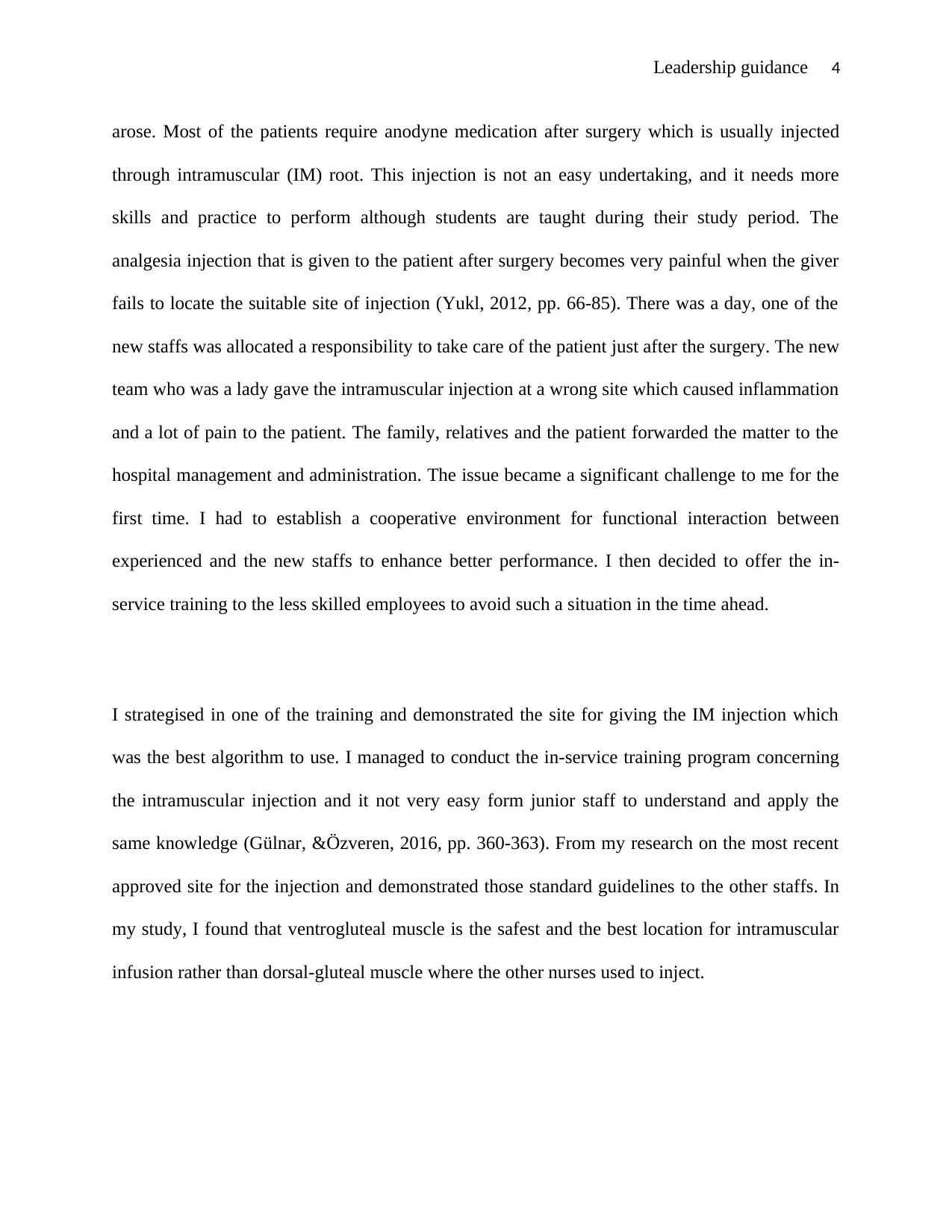
Leadership guidance 4
arose. Most of the patients require anodyne medication after surgery which is usually injected
through intramuscular (IM) root. This injection is not an easy undertaking, and it needs more
skills and practice to perform although students are taught during their study period. The
analgesia injection that is given to the patient after surgery becomes very painful when the giver
fails to locate the suitable site of injection (Yukl, 2012, pp. 66-85). There was a day, one of the
new staffs was allocated a responsibility to take care of the patient just after the surgery. The new
team who was a lady gave the intramuscular injection at a wrong site which caused inflammation
and a lot of pain to the patient. The family, relatives and the patient forwarded the matter to the
hospital management and administration. The issue became a significant challenge to me for the
first time. I had to establish a cooperative environment for functional interaction between
experienced and the new staffs to enhance better performance. I then decided to offer the in-
service training to the less skilled employees to avoid such a situation in the time ahead.
I strategised in one of the training and demonstrated the site for giving the IM injection which
was the best algorithm to use. I managed to conduct the in-service training program concerning
the intramuscular injection and it not very easy form junior staff to understand and apply the
same knowledge (Gülnar, &Özveren, 2016, pp. 360-363). From my research on the most recent
approved site for the injection and demonstrated those standard guidelines to the other staffs. In
my study, I found that ventrogluteal muscle is the safest and the best location for intramuscular
infusion rather than dorsal-gluteal muscle where the other nurses used to inject.
arose. Most of the patients require anodyne medication after surgery which is usually injected
through intramuscular (IM) root. This injection is not an easy undertaking, and it needs more
skills and practice to perform although students are taught during their study period. The
analgesia injection that is given to the patient after surgery becomes very painful when the giver
fails to locate the suitable site of injection (Yukl, 2012, pp. 66-85). There was a day, one of the
new staffs was allocated a responsibility to take care of the patient just after the surgery. The new
team who was a lady gave the intramuscular injection at a wrong site which caused inflammation
and a lot of pain to the patient. The family, relatives and the patient forwarded the matter to the
hospital management and administration. The issue became a significant challenge to me for the
first time. I had to establish a cooperative environment for functional interaction between
experienced and the new staffs to enhance better performance. I then decided to offer the in-
service training to the less skilled employees to avoid such a situation in the time ahead.
I strategised in one of the training and demonstrated the site for giving the IM injection which
was the best algorithm to use. I managed to conduct the in-service training program concerning
the intramuscular injection and it not very easy form junior staff to understand and apply the
same knowledge (Gülnar, &Özveren, 2016, pp. 360-363). From my research on the most recent
approved site for the injection and demonstrated those standard guidelines to the other staffs. In
my study, I found that ventrogluteal muscle is the safest and the best location for intramuscular
infusion rather than dorsal-gluteal muscle where the other nurses used to inject.
Secure Best Marks with AI Grader
Need help grading? Try our AI Grader for instant feedback on your assignments.
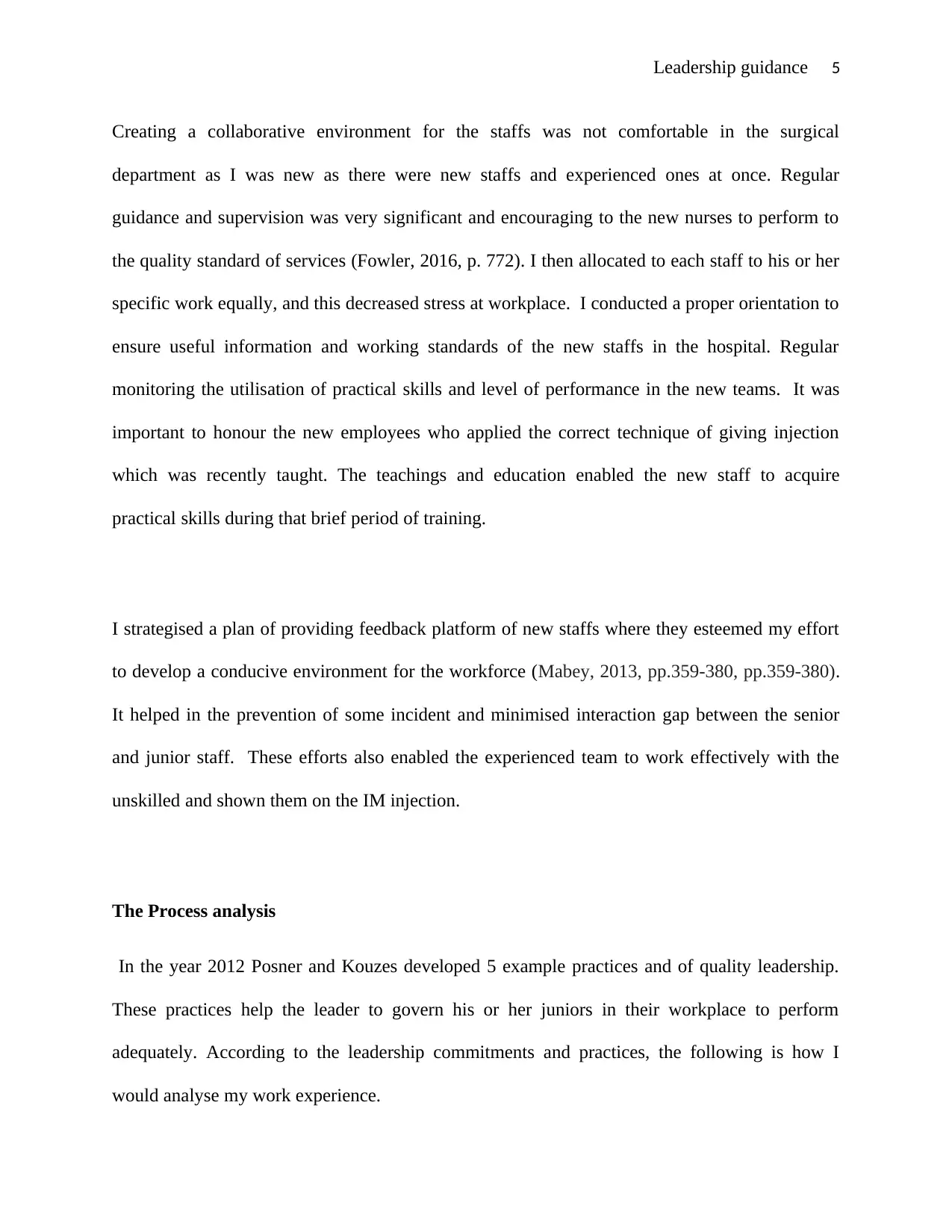
Leadership guidance 5
Creating a collaborative environment for the staffs was not comfortable in the surgical
department as I was new as there were new staffs and experienced ones at once. Regular
guidance and supervision was very significant and encouraging to the new nurses to perform to
the quality standard of services (Fowler, 2016, p. 772). I then allocated to each staff to his or her
specific work equally, and this decreased stress at workplace. I conducted a proper orientation to
ensure useful information and working standards of the new staffs in the hospital. Regular
monitoring the utilisation of practical skills and level of performance in the new teams. It was
important to honour the new employees who applied the correct technique of giving injection
which was recently taught. The teachings and education enabled the new staff to acquire
practical skills during that brief period of training.
I strategised a plan of providing feedback platform of new staffs where they esteemed my effort
to develop a conducive environment for the workforce (Mabey, 2013, pp.359-380, pp.359-380).
It helped in the prevention of some incident and minimised interaction gap between the senior
and junior staff. These efforts also enabled the experienced team to work effectively with the
unskilled and shown them on the IM injection.
The Process analysis
In the year 2012 Posner and Kouzes developed 5 example practices and of quality leadership.
These practices help the leader to govern his or her juniors in their workplace to perform
adequately. According to the leadership commitments and practices, the following is how I
would analyse my work experience.
Creating a collaborative environment for the staffs was not comfortable in the surgical
department as I was new as there were new staffs and experienced ones at once. Regular
guidance and supervision was very significant and encouraging to the new nurses to perform to
the quality standard of services (Fowler, 2016, p. 772). I then allocated to each staff to his or her
specific work equally, and this decreased stress at workplace. I conducted a proper orientation to
ensure useful information and working standards of the new staffs in the hospital. Regular
monitoring the utilisation of practical skills and level of performance in the new teams. It was
important to honour the new employees who applied the correct technique of giving injection
which was recently taught. The teachings and education enabled the new staff to acquire
practical skills during that brief period of training.
I strategised a plan of providing feedback platform of new staffs where they esteemed my effort
to develop a conducive environment for the workforce (Mabey, 2013, pp.359-380, pp.359-380).
It helped in the prevention of some incident and minimised interaction gap between the senior
and junior staff. These efforts also enabled the experienced team to work effectively with the
unskilled and shown them on the IM injection.
The Process analysis
In the year 2012 Posner and Kouzes developed 5 example practices and of quality leadership.
These practices help the leader to govern his or her juniors in their workplace to perform
adequately. According to the leadership commitments and practices, the following is how I
would analyse my work experience.
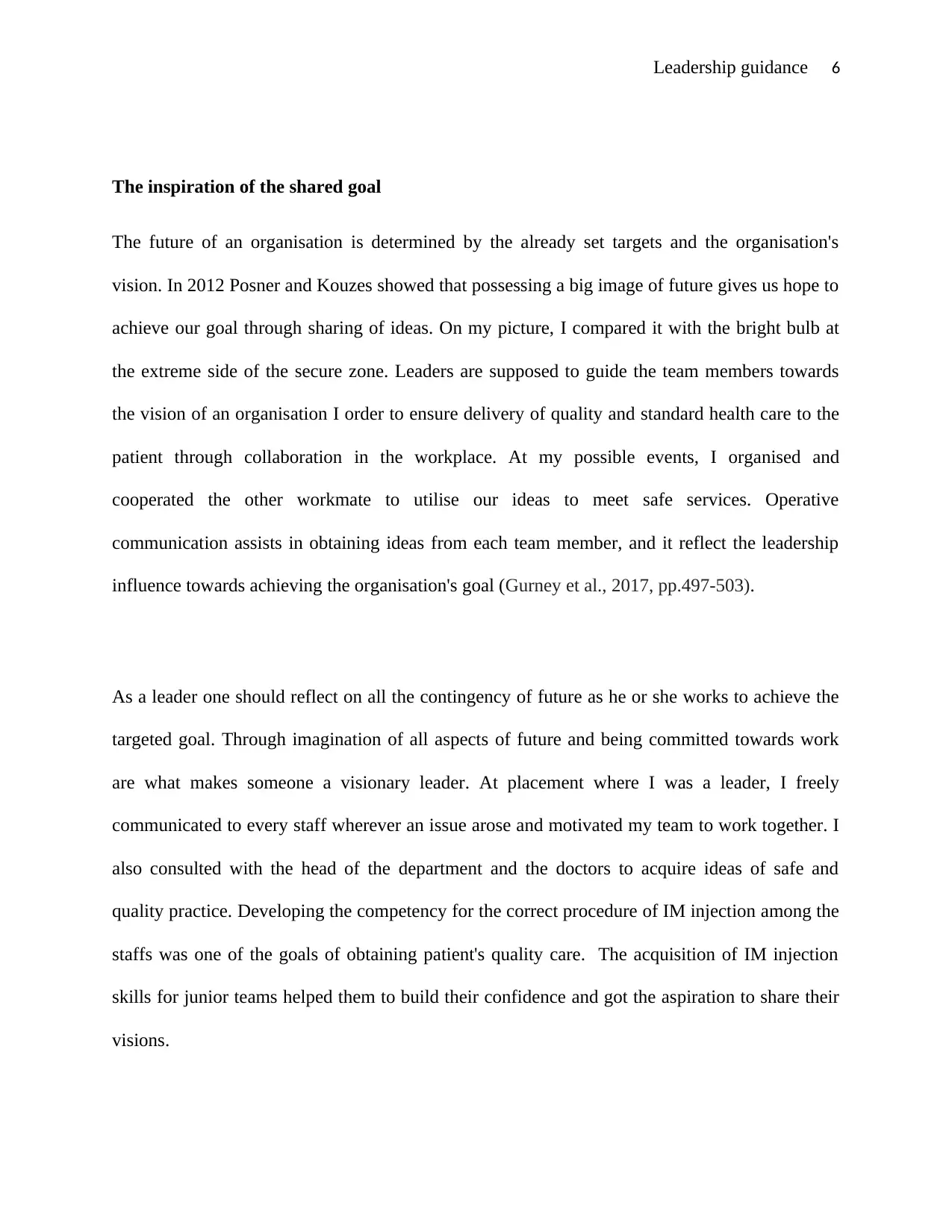
Leadership guidance 6
The inspiration of the shared goal
The future of an organisation is determined by the already set targets and the organisation's
vision. In 2012 Posner and Kouzes showed that possessing a big image of future gives us hope to
achieve our goal through sharing of ideas. On my picture, I compared it with the bright bulb at
the extreme side of the secure zone. Leaders are supposed to guide the team members towards
the vision of an organisation I order to ensure delivery of quality and standard health care to the
patient through collaboration in the workplace. At my possible events, I organised and
cooperated the other workmate to utilise our ideas to meet safe services. Operative
communication assists in obtaining ideas from each team member, and it reflect the leadership
influence towards achieving the organisation's goal (Gurney et al., 2017, pp.497-503).
As a leader one should reflect on all the contingency of future as he or she works to achieve the
targeted goal. Through imagination of all aspects of future and being committed towards work
are what makes someone a visionary leader. At placement where I was a leader, I freely
communicated to every staff wherever an issue arose and motivated my team to work together. I
also consulted with the head of the department and the doctors to acquire ideas of safe and
quality practice. Developing the competency for the correct procedure of IM injection among the
staffs was one of the goals of obtaining patient's quality care. The acquisition of IM injection
skills for junior teams helped them to build their confidence and got the aspiration to share their
visions.
The inspiration of the shared goal
The future of an organisation is determined by the already set targets and the organisation's
vision. In 2012 Posner and Kouzes showed that possessing a big image of future gives us hope to
achieve our goal through sharing of ideas. On my picture, I compared it with the bright bulb at
the extreme side of the secure zone. Leaders are supposed to guide the team members towards
the vision of an organisation I order to ensure delivery of quality and standard health care to the
patient through collaboration in the workplace. At my possible events, I organised and
cooperated the other workmate to utilise our ideas to meet safe services. Operative
communication assists in obtaining ideas from each team member, and it reflect the leadership
influence towards achieving the organisation's goal (Gurney et al., 2017, pp.497-503).
As a leader one should reflect on all the contingency of future as he or she works to achieve the
targeted goal. Through imagination of all aspects of future and being committed towards work
are what makes someone a visionary leader. At placement where I was a leader, I freely
communicated to every staff wherever an issue arose and motivated my team to work together. I
also consulted with the head of the department and the doctors to acquire ideas of safe and
quality practice. Developing the competency for the correct procedure of IM injection among the
staffs was one of the goals of obtaining patient's quality care. The acquisition of IM injection
skills for junior teams helped them to build their confidence and got the aspiration to share their
visions.
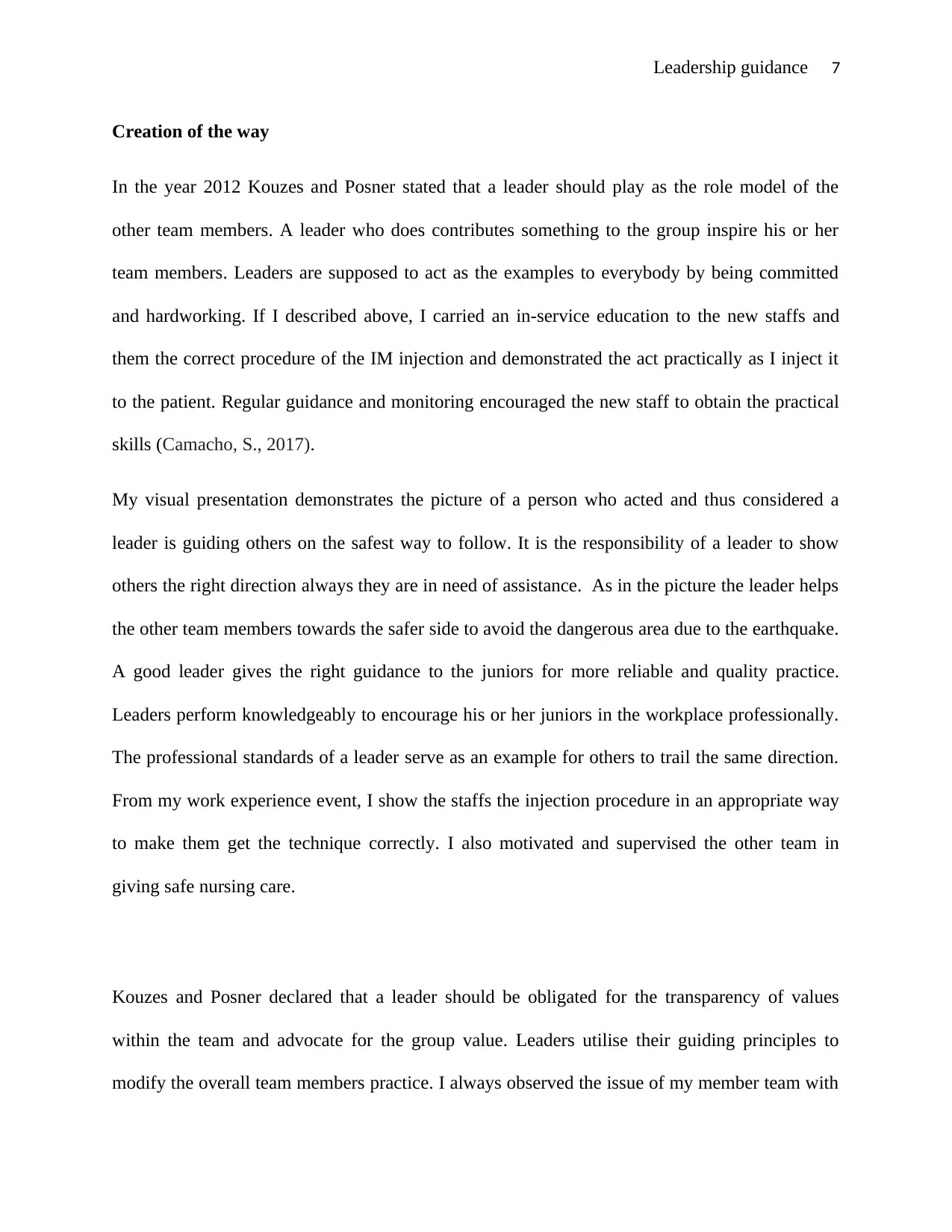
Leadership guidance 7
Creation of the way
In the year 2012 Kouzes and Posner stated that a leader should play as the role model of the
other team members. A leader who does contributes something to the group inspire his or her
team members. Leaders are supposed to act as the examples to everybody by being committed
and hardworking. If I described above, I carried an in-service education to the new staffs and
them the correct procedure of the IM injection and demonstrated the act practically as I inject it
to the patient. Regular guidance and monitoring encouraged the new staff to obtain the practical
skills (Camacho, S., 2017).
My visual presentation demonstrates the picture of a person who acted and thus considered a
leader is guiding others on the safest way to follow. It is the responsibility of a leader to show
others the right direction always they are in need of assistance. As in the picture the leader helps
the other team members towards the safer side to avoid the dangerous area due to the earthquake.
A good leader gives the right guidance to the juniors for more reliable and quality practice.
Leaders perform knowledgeably to encourage his or her juniors in the workplace professionally.
The professional standards of a leader serve as an example for others to trail the same direction.
From my work experience event, I show the staffs the injection procedure in an appropriate way
to make them get the technique correctly. I also motivated and supervised the other team in
giving safe nursing care.
Kouzes and Posner declared that a leader should be obligated for the transparency of values
within the team and advocate for the group value. Leaders utilise their guiding principles to
modify the overall team members practice. I always observed the issue of my member team with
Creation of the way
In the year 2012 Kouzes and Posner stated that a leader should play as the role model of the
other team members. A leader who does contributes something to the group inspire his or her
team members. Leaders are supposed to act as the examples to everybody by being committed
and hardworking. If I described above, I carried an in-service education to the new staffs and
them the correct procedure of the IM injection and demonstrated the act practically as I inject it
to the patient. Regular guidance and monitoring encouraged the new staff to obtain the practical
skills (Camacho, S., 2017).
My visual presentation demonstrates the picture of a person who acted and thus considered a
leader is guiding others on the safest way to follow. It is the responsibility of a leader to show
others the right direction always they are in need of assistance. As in the picture the leader helps
the other team members towards the safer side to avoid the dangerous area due to the earthquake.
A good leader gives the right guidance to the juniors for more reliable and quality practice.
Leaders perform knowledgeably to encourage his or her juniors in the workplace professionally.
The professional standards of a leader serve as an example for others to trail the same direction.
From my work experience event, I show the staffs the injection procedure in an appropriate way
to make them get the technique correctly. I also motivated and supervised the other team in
giving safe nursing care.
Kouzes and Posner declared that a leader should be obligated for the transparency of values
within the team and advocate for the group value. Leaders utilise their guiding principles to
modify the overall team members practice. I always observed the issue of my member team with
Paraphrase This Document
Need a fresh take? Get an instant paraphrase of this document with our AI Paraphraser
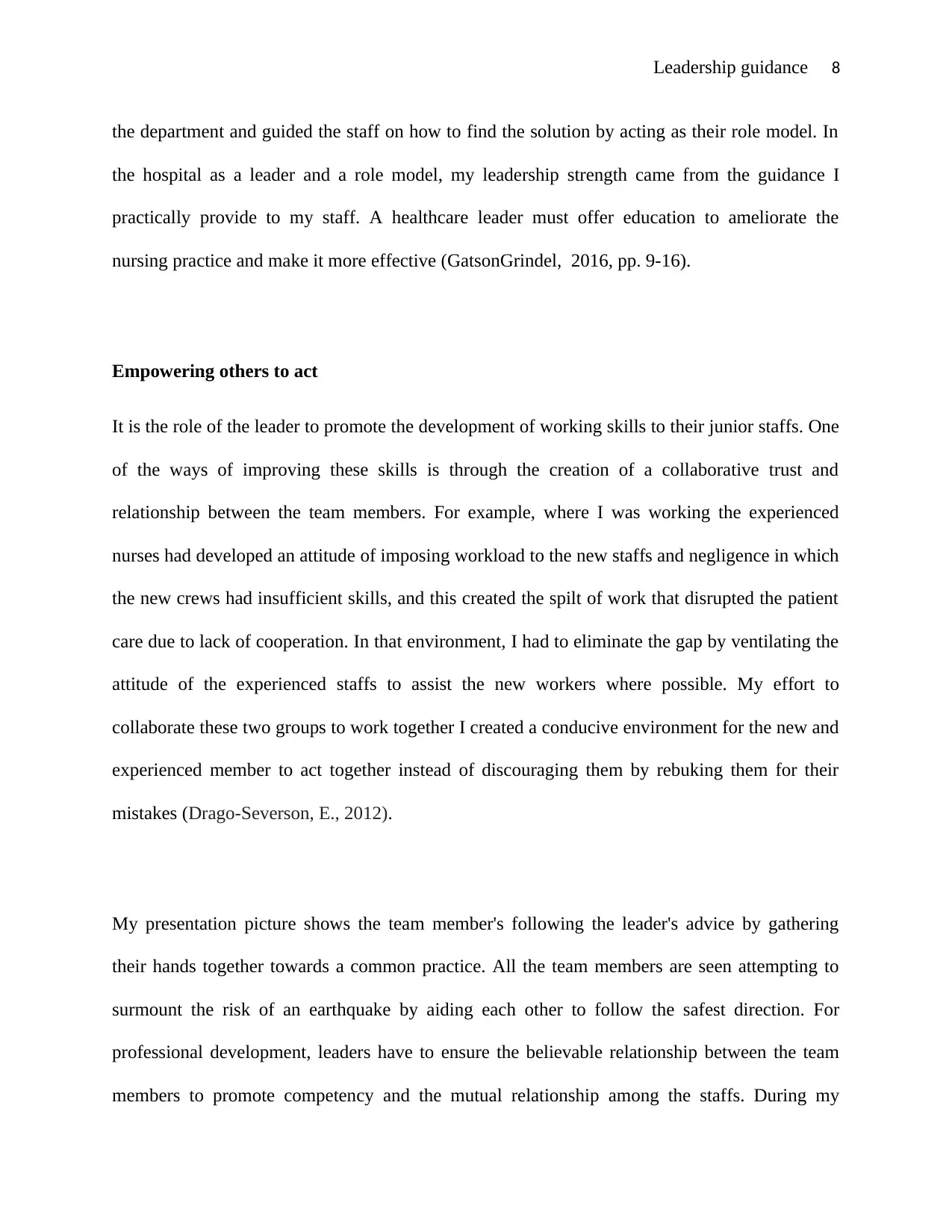
Leadership guidance 8
the department and guided the staff on how to find the solution by acting as their role model. In
the hospital as a leader and a role model, my leadership strength came from the guidance I
practically provide to my staff. A healthcare leader must offer education to ameliorate the
nursing practice and make it more effective (GatsonGrindel, 2016, pp. 9-16).
Empowering others to act
It is the role of the leader to promote the development of working skills to their junior staffs. One
of the ways of improving these skills is through the creation of a collaborative trust and
relationship between the team members. For example, where I was working the experienced
nurses had developed an attitude of imposing workload to the new staffs and negligence in which
the new crews had insufficient skills, and this created the spilt of work that disrupted the patient
care due to lack of cooperation. In that environment, I had to eliminate the gap by ventilating the
attitude of the experienced staffs to assist the new workers where possible. My effort to
collaborate these two groups to work together I created a conducive environment for the new and
experienced member to act together instead of discouraging them by rebuking them for their
mistakes (Drago-Severson, E., 2012).
My presentation picture shows the team member's following the leader's advice by gathering
their hands together towards a common practice. All the team members are seen attempting to
surmount the risk of an earthquake by aiding each other to follow the safest direction. For
professional development, leaders have to ensure the believable relationship between the team
members to promote competency and the mutual relationship among the staffs. During my
the department and guided the staff on how to find the solution by acting as their role model. In
the hospital as a leader and a role model, my leadership strength came from the guidance I
practically provide to my staff. A healthcare leader must offer education to ameliorate the
nursing practice and make it more effective (GatsonGrindel, 2016, pp. 9-16).
Empowering others to act
It is the role of the leader to promote the development of working skills to their junior staffs. One
of the ways of improving these skills is through the creation of a collaborative trust and
relationship between the team members. For example, where I was working the experienced
nurses had developed an attitude of imposing workload to the new staffs and negligence in which
the new crews had insufficient skills, and this created the spilt of work that disrupted the patient
care due to lack of cooperation. In that environment, I had to eliminate the gap by ventilating the
attitude of the experienced staffs to assist the new workers where possible. My effort to
collaborate these two groups to work together I created a conducive environment for the new and
experienced member to act together instead of discouraging them by rebuking them for their
mistakes (Drago-Severson, E., 2012).
My presentation picture shows the team member's following the leader's advice by gathering
their hands together towards a common practice. All the team members are seen attempting to
surmount the risk of an earthquake by aiding each other to follow the safest direction. For
professional development, leaders have to ensure the believable relationship between the team
members to promote competency and the mutual relationship among the staffs. During my
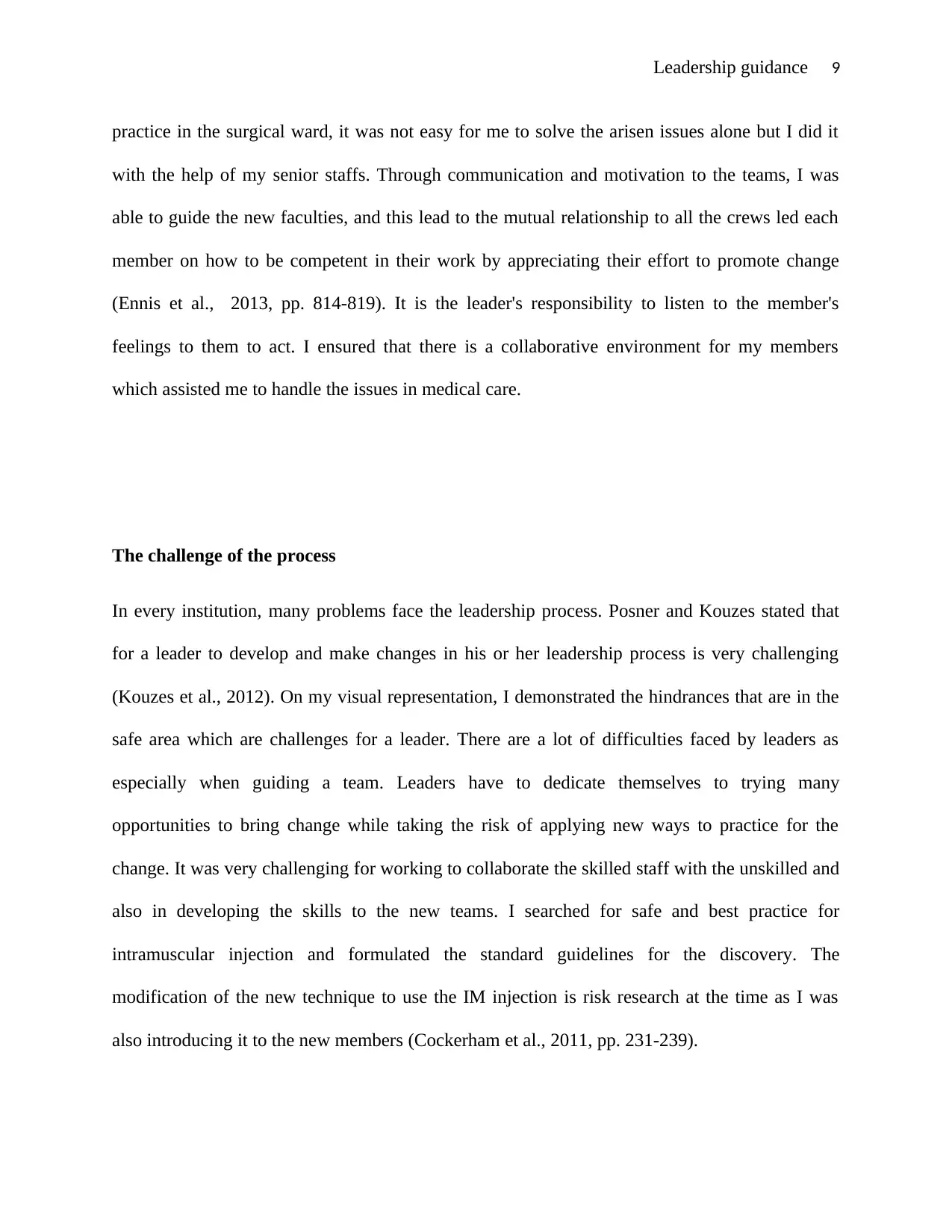
Leadership guidance 9
practice in the surgical ward, it was not easy for me to solve the arisen issues alone but I did it
with the help of my senior staffs. Through communication and motivation to the teams, I was
able to guide the new faculties, and this lead to the mutual relationship to all the crews led each
member on how to be competent in their work by appreciating their effort to promote change
(Ennis et al., 2013, pp. 814-819). It is the leader's responsibility to listen to the member's
feelings to them to act. I ensured that there is a collaborative environment for my members
which assisted me to handle the issues in medical care.
The challenge of the process
In every institution, many problems face the leadership process. Posner and Kouzes stated that
for a leader to develop and make changes in his or her leadership process is very challenging
(Kouzes et al., 2012). On my visual representation, I demonstrated the hindrances that are in the
safe area which are challenges for a leader. There are a lot of difficulties faced by leaders as
especially when guiding a team. Leaders have to dedicate themselves to trying many
opportunities to bring change while taking the risk of applying new ways to practice for the
change. It was very challenging for working to collaborate the skilled staff with the unskilled and
also in developing the skills to the new teams. I searched for safe and best practice for
intramuscular injection and formulated the standard guidelines for the discovery. The
modification of the new technique to use the IM injection is risk research at the time as I was
also introducing it to the new members (Cockerham et al., 2011, pp. 231-239).
practice in the surgical ward, it was not easy for me to solve the arisen issues alone but I did it
with the help of my senior staffs. Through communication and motivation to the teams, I was
able to guide the new faculties, and this lead to the mutual relationship to all the crews led each
member on how to be competent in their work by appreciating their effort to promote change
(Ennis et al., 2013, pp. 814-819). It is the leader's responsibility to listen to the member's
feelings to them to act. I ensured that there is a collaborative environment for my members
which assisted me to handle the issues in medical care.
The challenge of the process
In every institution, many problems face the leadership process. Posner and Kouzes stated that
for a leader to develop and make changes in his or her leadership process is very challenging
(Kouzes et al., 2012). On my visual representation, I demonstrated the hindrances that are in the
safe area which are challenges for a leader. There are a lot of difficulties faced by leaders as
especially when guiding a team. Leaders have to dedicate themselves to trying many
opportunities to bring change while taking the risk of applying new ways to practice for the
change. It was very challenging for working to collaborate the skilled staff with the unskilled and
also in developing the skills to the new teams. I searched for safe and best practice for
intramuscular injection and formulated the standard guidelines for the discovery. The
modification of the new technique to use the IM injection is risk research at the time as I was
also introducing it to the new members (Cockerham et al., 2011, pp. 231-239).
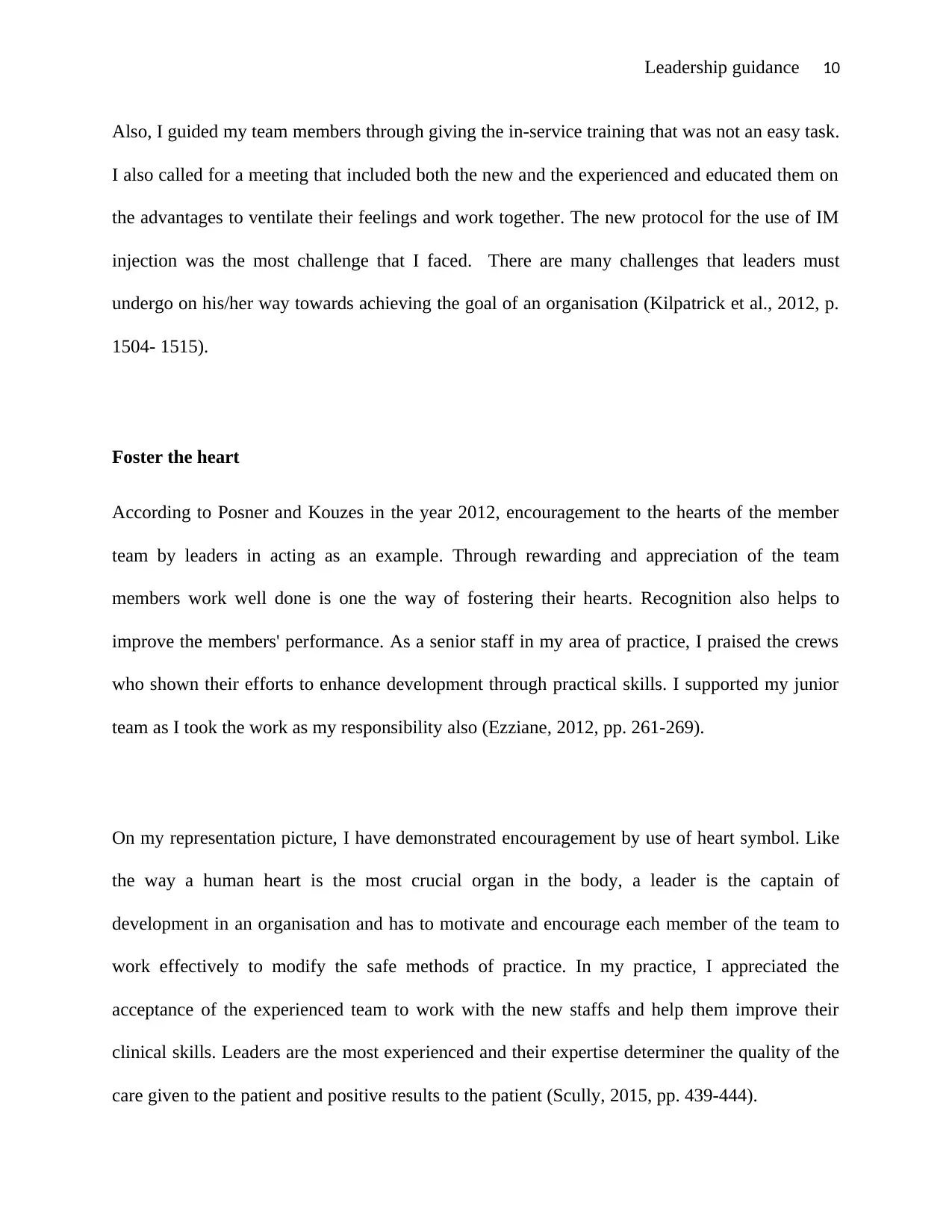
Leadership guidance 10
Also, I guided my team members through giving the in-service training that was not an easy task.
I also called for a meeting that included both the new and the experienced and educated them on
the advantages to ventilate their feelings and work together. The new protocol for the use of IM
injection was the most challenge that I faced. There are many challenges that leaders must
undergo on his/her way towards achieving the goal of an organisation (Kilpatrick et al., 2012, p.
1504- 1515).
Foster the heart
According to Posner and Kouzes in the year 2012, encouragement to the hearts of the member
team by leaders in acting as an example. Through rewarding and appreciation of the team
members work well done is one the way of fostering their hearts. Recognition also helps to
improve the members' performance. As a senior staff in my area of practice, I praised the crews
who shown their efforts to enhance development through practical skills. I supported my junior
team as I took the work as my responsibility also (Ezziane, 2012, pp. 261-269).
On my representation picture, I have demonstrated encouragement by use of heart symbol. Like
the way a human heart is the most crucial organ in the body, a leader is the captain of
development in an organisation and has to motivate and encourage each member of the team to
work effectively to modify the safe methods of practice. In my practice, I appreciated the
acceptance of the experienced team to work with the new staffs and help them improve their
clinical skills. Leaders are the most experienced and their expertise determiner the quality of the
care given to the patient and positive results to the patient (Scully, 2015, pp. 439-444).
Also, I guided my team members through giving the in-service training that was not an easy task.
I also called for a meeting that included both the new and the experienced and educated them on
the advantages to ventilate their feelings and work together. The new protocol for the use of IM
injection was the most challenge that I faced. There are many challenges that leaders must
undergo on his/her way towards achieving the goal of an organisation (Kilpatrick et al., 2012, p.
1504- 1515).
Foster the heart
According to Posner and Kouzes in the year 2012, encouragement to the hearts of the member
team by leaders in acting as an example. Through rewarding and appreciation of the team
members work well done is one the way of fostering their hearts. Recognition also helps to
improve the members' performance. As a senior staff in my area of practice, I praised the crews
who shown their efforts to enhance development through practical skills. I supported my junior
team as I took the work as my responsibility also (Ezziane, 2012, pp. 261-269).
On my representation picture, I have demonstrated encouragement by use of heart symbol. Like
the way a human heart is the most crucial organ in the body, a leader is the captain of
development in an organisation and has to motivate and encourage each member of the team to
work effectively to modify the safe methods of practice. In my practice, I appreciated the
acceptance of the experienced team to work with the new staffs and help them improve their
clinical skills. Leaders are the most experienced and their expertise determiner the quality of the
care given to the patient and positive results to the patient (Scully, 2015, pp. 439-444).
Secure Best Marks with AI Grader
Need help grading? Try our AI Grader for instant feedback on your assignments.
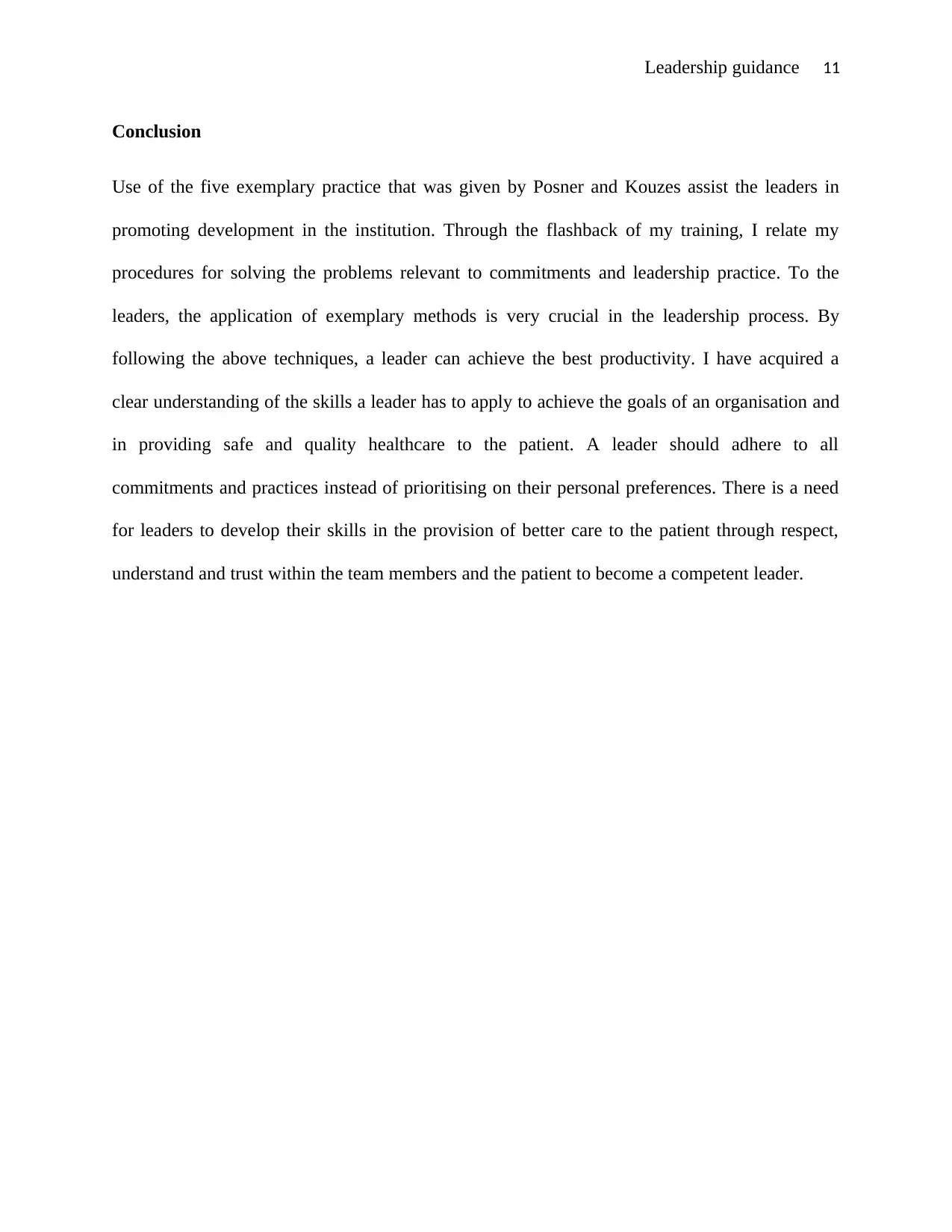
Leadership guidance 11
Conclusion
Use of the five exemplary practice that was given by Posner and Kouzes assist the leaders in
promoting development in the institution. Through the flashback of my training, I relate my
procedures for solving the problems relevant to commitments and leadership practice. To the
leaders, the application of exemplary methods is very crucial in the leadership process. By
following the above techniques, a leader can achieve the best productivity. I have acquired a
clear understanding of the skills a leader has to apply to achieve the goals of an organisation and
in providing safe and quality healthcare to the patient. A leader should adhere to all
commitments and practices instead of prioritising on their personal preferences. There is a need
for leaders to develop their skills in the provision of better care to the patient through respect,
understand and trust within the team members and the patient to become a competent leader.
Conclusion
Use of the five exemplary practice that was given by Posner and Kouzes assist the leaders in
promoting development in the institution. Through the flashback of my training, I relate my
procedures for solving the problems relevant to commitments and leadership practice. To the
leaders, the application of exemplary methods is very crucial in the leadership process. By
following the above techniques, a leader can achieve the best productivity. I have acquired a
clear understanding of the skills a leader has to apply to achieve the goals of an organisation and
in providing safe and quality healthcare to the patient. A leader should adhere to all
commitments and practices instead of prioritising on their personal preferences. There is a need
for leaders to develop their skills in the provision of better care to the patient through respect,
understand and trust within the team members and the patient to become a competent leader.
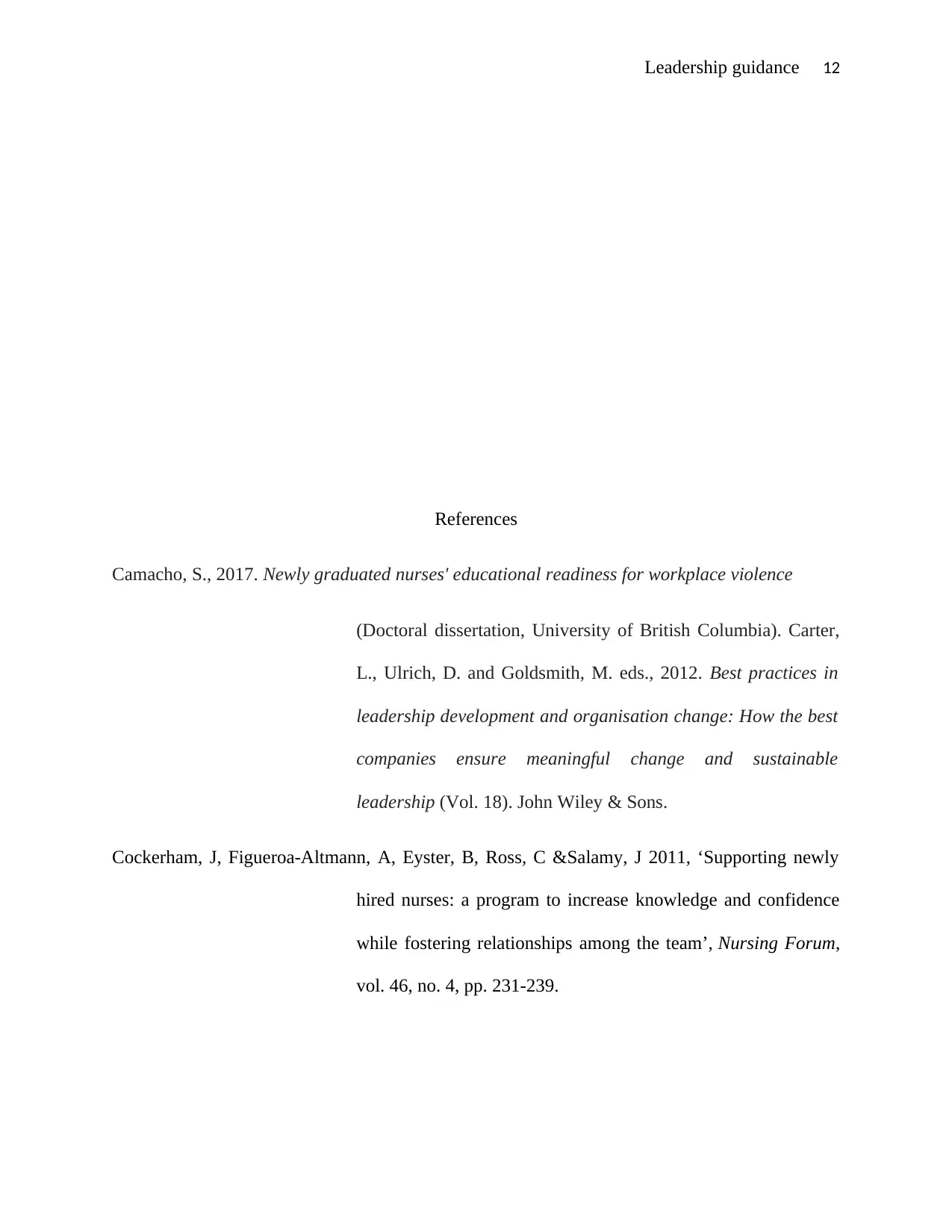
Leadership guidance 12
References
Camacho, S., 2017. Newly graduated nurses' educational readiness for workplace violence
(Doctoral dissertation, University of British Columbia). Carter,
L., Ulrich, D. and Goldsmith, M. eds., 2012. Best practices in
leadership development and organisation change: How the best
companies ensure meaningful change and sustainable
leadership (Vol. 18). John Wiley & Sons.
Cockerham, J, Figueroa-Altmann, A, Eyster, B, Ross, C &Salamy, J 2011, ‘Supporting newly
hired nurses: a program to increase knowledge and confidence
while fostering relationships among the team’, Nursing Forum,
vol. 46, no. 4, pp. 231-239.
References
Camacho, S., 2017. Newly graduated nurses' educational readiness for workplace violence
(Doctoral dissertation, University of British Columbia). Carter,
L., Ulrich, D. and Goldsmith, M. eds., 2012. Best practices in
leadership development and organisation change: How the best
companies ensure meaningful change and sustainable
leadership (Vol. 18). John Wiley & Sons.
Cockerham, J, Figueroa-Altmann, A, Eyster, B, Ross, C &Salamy, J 2011, ‘Supporting newly
hired nurses: a program to increase knowledge and confidence
while fostering relationships among the team’, Nursing Forum,
vol. 46, no. 4, pp. 231-239.
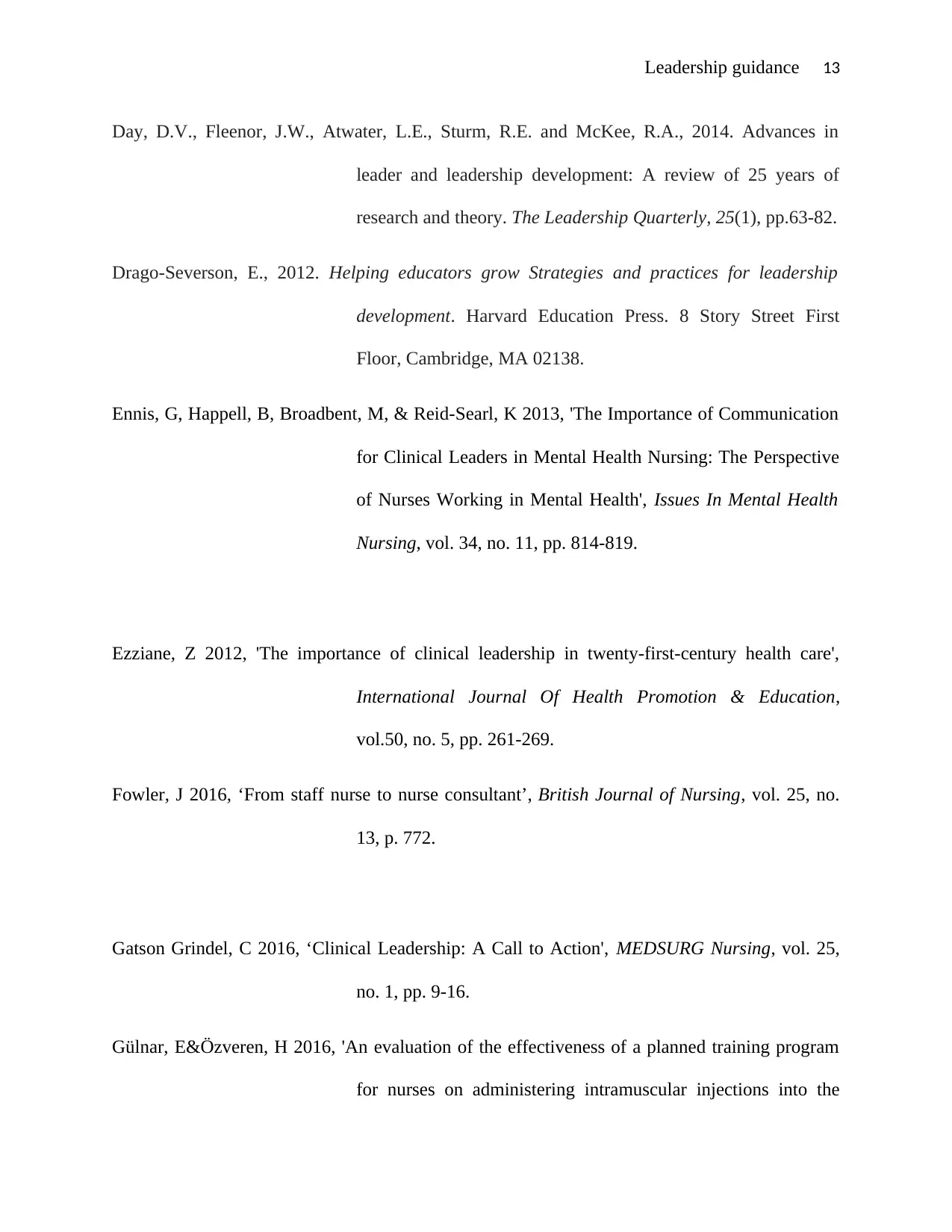
Leadership guidance 13
Day, D.V., Fleenor, J.W., Atwater, L.E., Sturm, R.E. and McKee, R.A., 2014. Advances in
leader and leadership development: A review of 25 years of
research and theory. The Leadership Quarterly, 25(1), pp.63-82.
Drago-Severson, E., 2012. Helping educators grow Strategies and practices for leadership
development. Harvard Education Press. 8 Story Street First
Floor, Cambridge, MA 02138.
Ennis, G, Happell, B, Broadbent, M, & Reid-Searl, K 2013, 'The Importance of Communication
for Clinical Leaders in Mental Health Nursing: The Perspective
of Nurses Working in Mental Health', Issues In Mental Health
Nursing, vol. 34, no. 11, pp. 814-819.
Ezziane, Z 2012, 'The importance of clinical leadership in twenty-first-century health care',
International Journal Of Health Promotion & Education,
vol.50, no. 5, pp. 261-269.
Fowler, J 2016, ‘From staff nurse to nurse consultant’, British Journal of Nursing, vol. 25, no.
13, p. 772.
Gatson Grindel, C 2016, ‘Clinical Leadership: A Call to Action', MEDSURG Nursing, vol. 25,
no. 1, pp. 9-16.
Gülnar, E&Özveren, H 2016, 'An evaluation of the effectiveness of a planned training program
for nurses on administering intramuscular injections into the
Day, D.V., Fleenor, J.W., Atwater, L.E., Sturm, R.E. and McKee, R.A., 2014. Advances in
leader and leadership development: A review of 25 years of
research and theory. The Leadership Quarterly, 25(1), pp.63-82.
Drago-Severson, E., 2012. Helping educators grow Strategies and practices for leadership
development. Harvard Education Press. 8 Story Street First
Floor, Cambridge, MA 02138.
Ennis, G, Happell, B, Broadbent, M, & Reid-Searl, K 2013, 'The Importance of Communication
for Clinical Leaders in Mental Health Nursing: The Perspective
of Nurses Working in Mental Health', Issues In Mental Health
Nursing, vol. 34, no. 11, pp. 814-819.
Ezziane, Z 2012, 'The importance of clinical leadership in twenty-first-century health care',
International Journal Of Health Promotion & Education,
vol.50, no. 5, pp. 261-269.
Fowler, J 2016, ‘From staff nurse to nurse consultant’, British Journal of Nursing, vol. 25, no.
13, p. 772.
Gatson Grindel, C 2016, ‘Clinical Leadership: A Call to Action', MEDSURG Nursing, vol. 25,
no. 1, pp. 9-16.
Gülnar, E&Özveren, H 2016, 'An evaluation of the effectiveness of a planned training program
for nurses on administering intramuscular injections into the
Paraphrase This Document
Need a fresh take? Get an instant paraphrase of this document with our AI Paraphraser
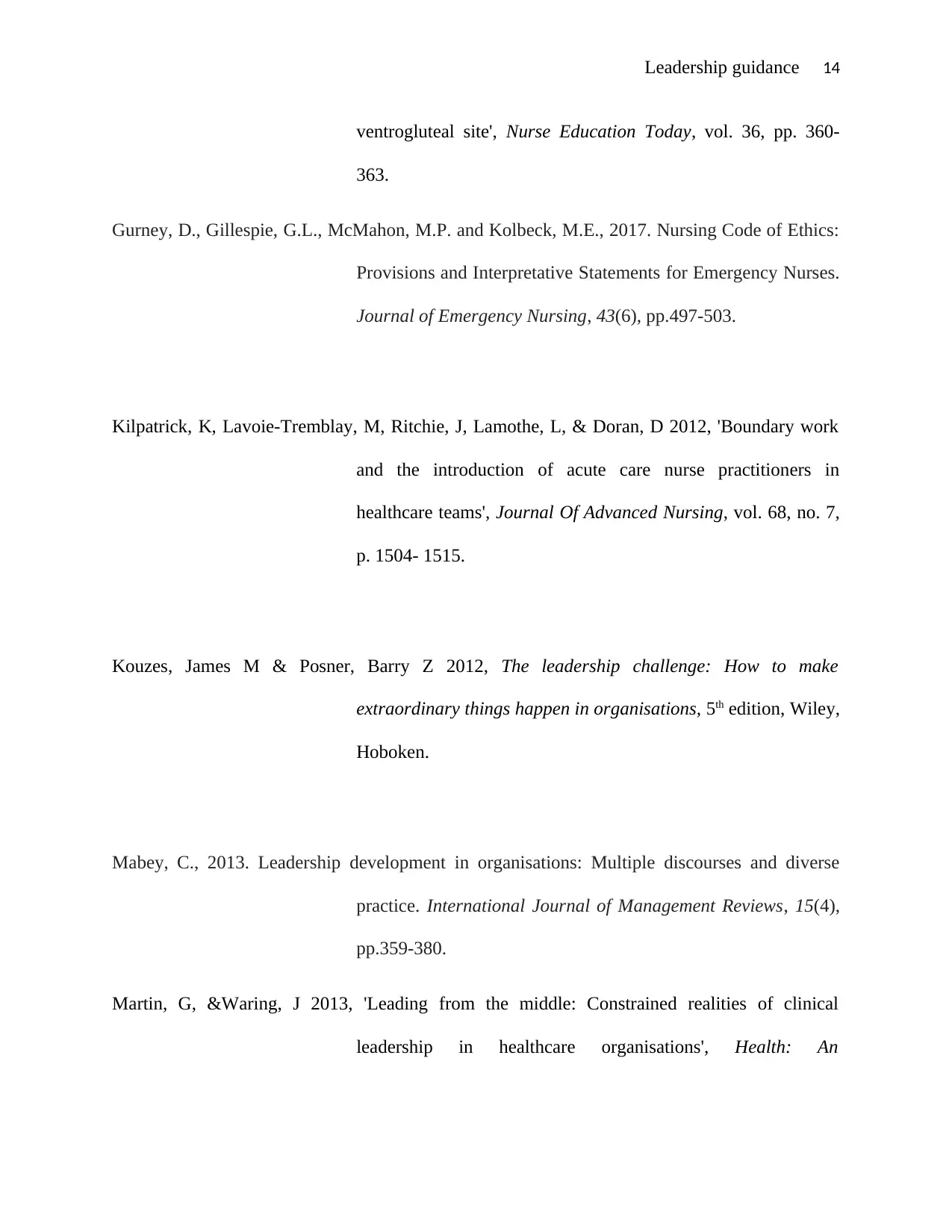
Leadership guidance 14
ventrogluteal site', Nurse Education Today, vol. 36, pp. 360-
363.
Gurney, D., Gillespie, G.L., McMahon, M.P. and Kolbeck, M.E., 2017. Nursing Code of Ethics:
Provisions and Interpretative Statements for Emergency Nurses.
Journal of Emergency Nursing, 43(6), pp.497-503.
Kilpatrick, K, Lavoie-Tremblay, M, Ritchie, J, Lamothe, L, & Doran, D 2012, 'Boundary work
and the introduction of acute care nurse practitioners in
healthcare teams', Journal Of Advanced Nursing, vol. 68, no. 7,
p. 1504- 1515.
Kouzes, James M & Posner, Barry Z 2012, The leadership challenge: How to make
extraordinary things happen in organisations, 5th edition, Wiley,
Hoboken.
Mabey, C., 2013. Leadership development in organisations: Multiple discourses and diverse
practice. International Journal of Management Reviews, 15(4),
pp.359-380.
Martin, G, &Waring, J 2013, 'Leading from the middle: Constrained realities of clinical
leadership in healthcare organisations', Health: An
ventrogluteal site', Nurse Education Today, vol. 36, pp. 360-
363.
Gurney, D., Gillespie, G.L., McMahon, M.P. and Kolbeck, M.E., 2017. Nursing Code of Ethics:
Provisions and Interpretative Statements for Emergency Nurses.
Journal of Emergency Nursing, 43(6), pp.497-503.
Kilpatrick, K, Lavoie-Tremblay, M, Ritchie, J, Lamothe, L, & Doran, D 2012, 'Boundary work
and the introduction of acute care nurse practitioners in
healthcare teams', Journal Of Advanced Nursing, vol. 68, no. 7,
p. 1504- 1515.
Kouzes, James M & Posner, Barry Z 2012, The leadership challenge: How to make
extraordinary things happen in organisations, 5th edition, Wiley,
Hoboken.
Mabey, C., 2013. Leadership development in organisations: Multiple discourses and diverse
practice. International Journal of Management Reviews, 15(4),
pp.359-380.
Martin, G, &Waring, J 2013, 'Leading from the middle: Constrained realities of clinical
leadership in healthcare organisations', Health: An
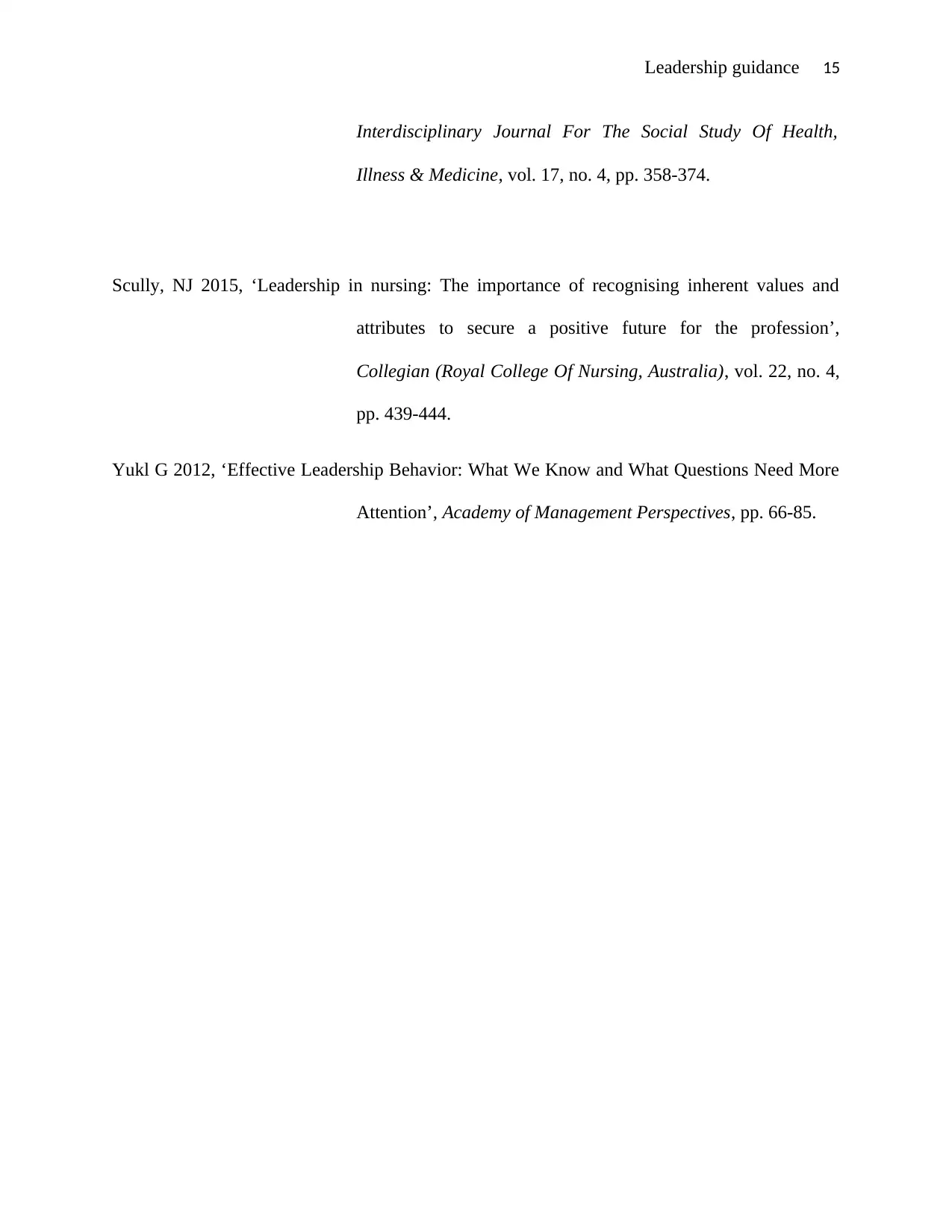
Leadership guidance 15
Interdisciplinary Journal For The Social Study Of Health,
Illness & Medicine, vol. 17, no. 4, pp. 358-374.
Scully, NJ 2015, ‘Leadership in nursing: The importance of recognising inherent values and
attributes to secure a positive future for the profession’,
Collegian (Royal College Of Nursing, Australia), vol. 22, no. 4,
pp. 439-444.
Yukl G 2012, ‘Effective Leadership Behavior: What We Know and What Questions Need More
Attention’, Academy of Management Perspectives, pp. 66-85.
Interdisciplinary Journal For The Social Study Of Health,
Illness & Medicine, vol. 17, no. 4, pp. 358-374.
Scully, NJ 2015, ‘Leadership in nursing: The importance of recognising inherent values and
attributes to secure a positive future for the profession’,
Collegian (Royal College Of Nursing, Australia), vol. 22, no. 4,
pp. 439-444.
Yukl G 2012, ‘Effective Leadership Behavior: What We Know and What Questions Need More
Attention’, Academy of Management Perspectives, pp. 66-85.
1 out of 15
Related Documents
Your All-in-One AI-Powered Toolkit for Academic Success.
+13062052269
info@desklib.com
Available 24*7 on WhatsApp / Email
![[object Object]](/_next/static/media/star-bottom.7253800d.svg)
Unlock your academic potential
© 2024 | Zucol Services PVT LTD | All rights reserved.





